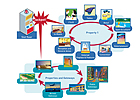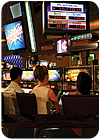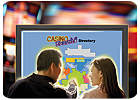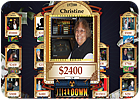Already a vital promotional tool, technologically powerful signage is offering more versatility to target messages to customers and to be more interactive

Casinos have long stressed the individual versus the house aspect of gaming. But with the recent introduction of some innovative new game designs, slot and table game manufacturers are creating a new competitive gaming atmosphere in which community-based games are allowing players to interact with each other and to compete for and share in bonuses and jackpots.
TIt’s a neon jungle out there, and with so many choices available, casinos are increasingly turning to cutting-edge digital signage technology to differentiate the property from competitors and to draw customer attention to specific areas and opportunities.
Although a relatively new phenomenon, digital signage already has become a major marketing tool inside casinos, explained Brent Brown, vice president and chief information officer of International Business Systems (IBS) Inc., based in Mercer Island, Wash.
They can be used to enhance the players’ overall experience, boost profits by influencing what customers demand on premises, and to burnish a casino’s image.
Current digital signs are an indirect descendant of the huge electronic signs used outside casinos to entice customers inside with ads for current and future entertainments, sporting events and new gaming options.
Reduced to a more personal size, these indoor digital signs perform the same marketing mission, but also can be personalized for customers. Some can target promotional messages to individual customers based on their known preferences (from data collected on past visits through player card systems) and encourage customer interaction (such as ordering deli sandwiches so they’ll be ready when one gets to the front of the line).
“The best part is that they put casino management in the driver’s seat by enabling them to create and schedule the marketing messages to gain maximum exposure to the most receptive audience,” Brown added.
Digital signage results from a collaboration of various computer component experts, combining hardware (from Dell, Hewlett-Packard, etc.), plasma and LCD screens (from LG, Panasonic, NEC, etc.) and software (3M, Cisco, Planar, etc.). But the most important component, said Brown, is “the message; the content that attracts attention from the customer.”
Firms such as IBS and Harris Broadcast Communications offer help to casinos in creating content, including templates in which to insert text, photos and videos.
Once content is created, a standard desktop Windows PC can be used to dispatch the data to its appropriate locale, and ultimately transmitted over a standard network (Ethernet) to the digital signs. These signs, while most often plasma screens, can also be LCD screens, LCD projector and laser projectors. Such signs can be placed almost anywhere a casino manager can imagine, including on elevators and in parking garages, Brown noted.

A natural fit
One of the best places to reach players is to place digital signs on the gaming floor adjacent to slots and table games.
The InfoCaster digital signage solution marketed by Harris Broadcast Communications, Mason, Ohio, is designed to interface with Bally Technologies’ and Paltronics’ slot gaming systems. to provide players with useful information and promotional messages.
InfoCaster comes with a complete suite of systems for creating, scheduling, distributing, playing and reporting live video and graphics on HDTV-quality screens throughout the gaming floor. Users can acquire or create digital content and manage it throughout the entire delivery chain from a central site or multiple remote locations along the digital signage network.
InfoCaster’s media controller also enables the system – using XML schemes – to grab rapidly changing data from Bally and Paltronics slots and continually update and display in real time the value of the progressive jackpot for a bank of linked slot machines. No matter where the guest plays, he need only glance at the digital screen to know the size of the jackpot, which can encourage him to play longer. And should the jackpot be hit, InfoCaster relays on digital signs throughout the gaming area the size of the win and location of the winner’s machine. This information also can be relayed to other digital signs throughout the casino property.
Other data InfoCaster can distribute throughout the digital sign network include current casino promotions, a list of daily events, acknowledgement of organizations meeting on premises, restaurant hours and menus, and live video. In addition to broadcasting promotional data, InfoCaster’s technology also enables casinos to target specific audiences, or narrowcast, throughout the entire property.

Delivering that winning feeling
Gaming Support B.V., Rotterdam and Las Vegas, offers three levels of promotional digital signage through its JackpotJunction platform.
JackpotJunction Lite is a standalone media controller with two software components (Video Junction and Jackpot Data Exchange) that enables promotions at the slot bank level. Besides encouraging players to try the newest slots games on the floor, this system also alerts players of winners in the vicinity. JackpotJunction Pro is a venue-wide digital marketing system that creates a fully integrated multizone broadcast environment that enable multimedia broadcasts in all corners of a property, including gaming, hospitality, retail and restaurants.
JackpotJunction XL is a multivenue broadcast management system that enables delivery of multimedia and integrated gaming content to all properties of a single enterprise. This server-based system sends promotional content through the Internet to each location, yet allows individual locations to add local content.
One feature of all JackpotJunction systems is the ability to send live video to screens throughout the network. Casinos often experience a one-third drop in play during a major sporting event, so its systems can send a video feed of that game through the network, reducing promotions to a text crawl at the bottom of the screen, said Nick Hogan, Gaming Support vice president of sales and marketing.
Video of the game can be interrupted to congratulate a winner, though the company has added an override to avoid a situation that happened in a Greek casino. A World Cup soccer game came down to an overtime kick, and just as the player was about to kick the ball for what would be the winning shot, the video was interrupted to congratulate a minor winner. “They almost had a riot on their hands,” Hogan noted.
While Gaming Support offers templates to help clients create digital signage content, Hogan suggests casinos can do better hiring the services of advertising professionals. “You have only two seconds to grab customers’ eyeballs,” he said. “The better the content, the more looks. And one also should have a greater variety of promotional and other content, as running the same stuff over and over gets stale in a hurry and inadvertently trains customers not to look.” Path411 from IBS is a complete digital signage suite that serves many needs throughout a casino property.
The Digital Signage Network is designed to enhance a casino’s brand by incorporating live and dynamic data within its key messaging system. Casinos can use text, moving graphics, animation and streaming video to promote on-premises events, entertainment, restaurants, ultralounges, and amenities like golf and spas in a manner that both informs and entertains viewers. Content can be input from remote locations, but it is controlled from a central location on the property.
Winner’s Playlist not only directs players to their favorite games, but also provides a showcase for big winners. Soon after a player scores a big win, a congratulatory message noting the player’s name, his photo (from his player card), game played and date of the bonanza goes into rotation on screens throughout the gaming floor. The constant motion of changing messages and winner’s happy faces attracts guests’ attention, and knowing which games paid off also entices guests to try them. Casinos have the option to also display the content playing on Winner’s Playlist on the property’s CATV channel.

Dynamic changes
The Path411 Digital Menu Board enables casino foodservice venues to easily change what is offered without printing new handheld menus or addendums to existing menus. Using any remote computer using a Windows operating system, meal choices can be rotated on and off the board as required. One-day specials can appear as part of the regular menu, and prices can be instantly and seamlessly altered as warranted (instead of altered by pen on static menus). Menus can be spread out over several screens.
Micros Systems Inc., based in Columbia, Md., also offers a digital menu board that can easily be changed and upgraded from a central computer as part of Micros’ RES.40 POS (point-of-sale) system. Using plasma video screens that can be placed around casual dining and bars around casinos, the board displays menu items in crisp easy-to-read letters with full-color illustrations. From a central location, restaurant manager can quickly change prices as required and to alter the menu to include specials and season-specific menu items. The boards also can be programmed to switch from lunch to dinner menus (or in bars during Happy Hour) at the same time daily.
Features of this digital menu sign include the ability to create the sign as one would design a web page. The system incorporates a web browser, ASP applications, and a web service to deliver customized content to the menu sign. Custom content can include the use of attention-getting graphics that can grab hungry customers as they walk by, said Jennifer Hauf, Micros marketing specialist.
Interactive digital signage is made possible by the MicroTouch DST System, the latest hardware component offered by 3M Touch Systems, based in Methuen, Mass.
By adding a critical interactive touch feature, digital signs can not only provide information to guests, but also help them find what they need inside the property, said David Henry, marketing retail business manager at 3M.
“Interactive Wayfinders set up at crucial locations [are] interactive signs can perform many vital services,” Henry explained. “Customers can use them to locate favorite slot machines and table games, thus eliminating wasted walking around time and perhaps result in longer playing time. The signs also can direct guest to restaurants by the type of food served, find out where to go to find rooms and other features around large resort-casino properties.
“Once a casino gets a handle on the abilities of these interactive signs, there is no telling what you can do with them,” Henry said.
These additional tasks can include helping guests select hotel rooms based on layout; reserve seating in the poker room; make reservations for dining, shows and golf tee-off times; and even pre-order meals so guests can be served as soon as you are seated.
Interfaced with player cards, signs need only receive information that you want to play a little Texas Hold’em and it will automatically reserve a favorite seat at a favorite table, and arrange to have a favorite quaff delivered to your seat soon after you begin play.
Current MicroTouch displays are made of chemically strengthened glass through which fast touch responses can be made unaffected by surface contaminants. The surface is treated to minimize glare. Offered in sizes from 32-to-46 inches wide, these displays have no moving parts, thus making them virtually maintenance free.
Casinos can expect even better and more effective digital signage choices in the near future. “As the market for such signs increases, manufacturers are trying to increase their share of the market by engaging in a battle of one-upsmanship, trying to develop the best and most technologically advanced systems they can,” Gaming Support’s Hogan said. “There is no end in sight.”